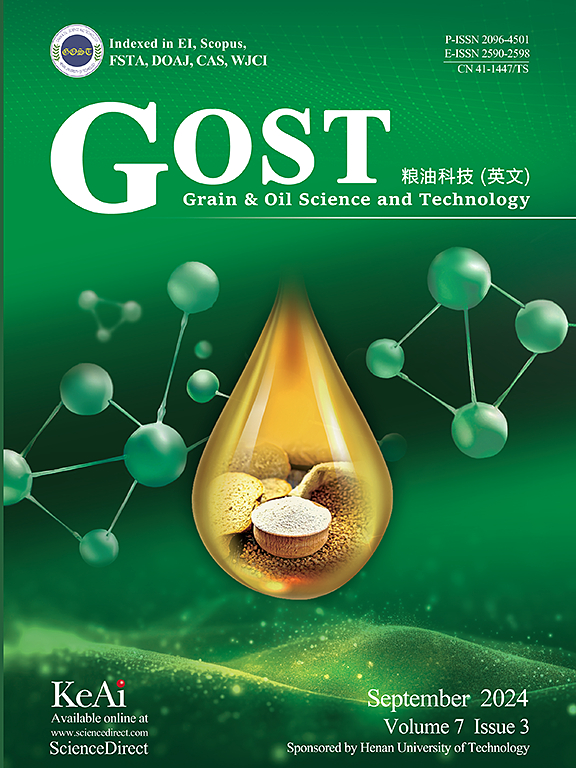Effect of ultrasound-assisted aqueous enzymatic extraction on the interfacial properties of high-oleic peanut oil bodies
Q2 Agricultural and Biological Sciences
引用次数: 0
Abstract
Oil bodies (OBs) are the lipid-storage organelle in oilseed, and their interface properties are crucial for oilseed processing. To elucidate the effect of interfacial proteins on the functional properties of high-oleic and normal peanut OBs, OBs were extracted using ultrasound-assisted aqueous enzymatic extraction (AEE), and the effects of ultrasonic power (100–500 W) and extraction time (0–30 min) on the interface properties were investigated. These results indicate that the interfacial protein content and interface properties of OBs can be significantly affected by ultrasonic treatment. The interfacial protein content of high-oleic peanut OBs increased from 88.25% to 91.95% after ultrasonic treatment, which was 1.4 times that of normal peanuts OBs. The emulsifying activity index (EAI) and emulsion stability index (ESI) values of both peanut OBs increased with the increase in ultrasonic power and extraction time. These results suggest that the emulsification ability of OBs may be closely related to the interfacial protein content and therefore can be regulated by altering the interfacial protein content using ultrasonic treatment. However, the particle size of OBs tends to increase under low ultrasonic power (0–200 W) owing to the increase in the interfacial protein content and aggregation effects, whereas it decreases under high ultrasonic power (300 W–500 W) due to cavitation effects. This pattern of change in particle size was also confirmed by confocal laser scanning microscopy, which indicated that high ultrasonic power suppressed the contribution of the interfacial protein content to the particle size, but still improved the emulsification ability of the OBs by reducing the particle size and increasing the interfacial tension. Therefore, regulating the interfacial protein content of peanut OBs by adjusting ultrasonic power is a promising way to improve their functional properties.

超声辅助水酶萃取对高含油花生油体界面性质的影响
油体是油籽中的储脂细胞器,其界面性质对油籽加工至关重要。为研究界面蛋白对高油酸花生和普通花生OBs功能特性的影响,采用超声辅助水酶萃取法(AEE)提取OBs,考察了超声功率(100-500 W)和提取时间(0-30 min)对OBs界面特性的影响。结果表明,超声处理对OBs的界面蛋白含量和界面性能有显著影响。超声处理后,高油酸花生ob的界面蛋白含量由88.25%提高到91.95%,是正常花生ob的1.4倍。两种花生OBs的乳化活性指数(EAI)和乳化稳定性指数(ESI)值均随超声功率和提取时间的增加而增加。这些结果表明,OBs的乳化能力可能与界面蛋白含量密切相关,因此可以通过超声处理改变界面蛋白含量来调节OBs的乳化能力。在低超声功率(0 ~ 200 W)下,由于界面蛋白含量的增加和聚集作用,OBs的粒径有增大的趋势,而在高超声功率(300 W ~ 500 W)下,由于空化作用,OBs的粒径减小。激光共聚焦扫描显微镜也证实了这种粒径变化规律,说明高超声功率抑制了界面蛋白含量对粒径的贡献,但仍然通过减小粒径和增加界面张力来提高OBs的乳化能力。因此,通过调节超声波功率来调节花生OBs的界面蛋白含量是改善其功能特性的一种很有前景的方法。
本文章由计算机程序翻译,如有差异,请以英文原文为准。
求助全文
约1分钟内获得全文
求助全文
来源期刊

Grain Oil Science and Technology
Food Science
CiteScore
7.30
自引率
0.00%
发文量
69
审稿时长
12 weeks
期刊介绍:
 求助内容:
求助内容: 应助结果提醒方式:
应助结果提醒方式:


